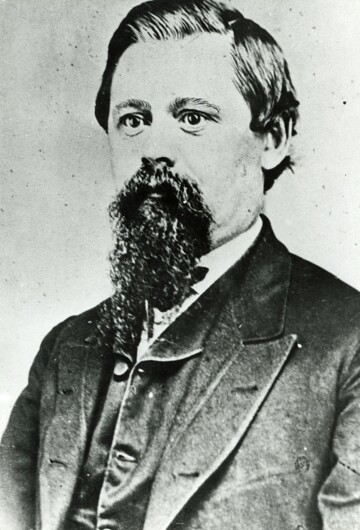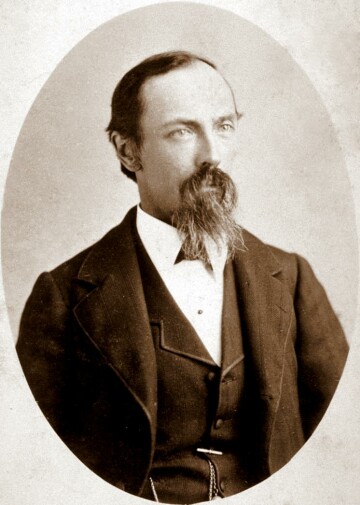Names in Bozeman’s Backyard: The Madison, The Gallatin and The Bridger Ranges
Sunday Mar. 1st, 2020
“Name, though it seem but a superficial and outward manner, yet it carryieth much impression and enchantment.” Francis Bacon (1561-1626)
As the Anglo-Europeans spread across the North American continent, the land became filled with names. It was a way of taking possession, of finding familiarity, of establishing location. The Gallatin Valley and surrounding mountains were no different as virtually all the prominent landmarks—peaks, lakes and streams—acquired a name.
Many were named for people prominent at the time. The principle rivers, thanks to Lewis and Clark, carry the names of some of the Founding Fathers. All of us know of John Bozeman and Jim Bridger who led wagon trains to the area in the late 1860s. Bridger, in 1846, along with Kit Carson, Osborn Russell, and W.F. Drannon, was even known to have trapped in the mountains named for him, and it was Russell who first called it Bridger Canyon. There were others of historical note, too, but what of the many other names? As you pull out the topo maps to plan the hike, fishing, or pack trip, the paper swirls with names. It is rather like wandering through a cemetery. Gravestones are everywhere, but they are limited to a name, dates, and a short epitaph. Certainly, just as with our maps, there is more to the story. There is more than just the family’s remembrance. Wouldn’t it be nice to know more about George Hammond than that he lived on that creek? Wouldn’t it be good to be able to put a face on John Reese or the story behind Watkins Creek? Where did the names for Mount Bole, Levinski Ridge, and Brackett Creek come from?
 General Lester S. Willson. Photograph courtesy of the Gallatin History Museum
General Lester S. Willson. Photograph courtesy of the Gallatin History Museum
The urge to delve into all these names in Bozeman’s Backyard began for me two and a half years ago when the Lone Mountain Land Company and the Marriott Corporation announced the start of a new hotel in Big Sky to be named The Wilson. They picked the name because it looked towards Mount Wilson in the Spanish Peaks and because 2017 was the 100th anniversary of President Wilson’s signing of the bill that created the National Park Service. But wait. I have a map from 1895 that shows Mt. Wilson and, at that time, Woodrow was still teaching Classical Latin and Greek and was unknown to the national public. A little searching at the Gallatin History Museum and the State Historical Society Archives in Helena revealed that this mountain was really named to honor General Lester S. Willson (1839-1919), a Civil War hero who marched with Sherman to the sea and had been honored with leading the Union Army into Savannah, GA when that city fell. After the war, he came to Bozeman where he ran a mercantile business with his brother, served in the 1868 Territorial Legislature, and was quartermaster general of Montana under two governors. Although listed in the 1900 Progressive Men of Montana, except for when Central Avenue was changed to Willson to honor him after his death in 1919, he has been rather lost to history, and superseded in local fame by his son, the architect, Fred Willson. What? You say! Their names have two “l”s and the mountain only one. Well, it seems that someone at the Board of Geographic Names in the 1890s knew how to spell Wilson better than they did. Col. Albert G. Brackett, 9th Illinois Cavalry. Courtesy of the Medford Historical Society & Museum
Col. Albert G. Brackett, 9th Illinois Cavalry. Courtesy of the Medford Historical Society & Museum
This “correcting” by a government agency was not uncommon, and is found throughout the West. Locally, there is another example that should be familiar to people of Bozeman. In the Gallatin Range east of town is a Mount Chestnut, named for Col. James D. Chesnut. Another Civil War veteran, he came to Bozeman in 1867 and had one of the first log buildings in the town, Chesnut Corner, on Bozeman and Main. Prospecting as most locals did, he discovered a coal seam near the present I-90 Trail Creek exit #316 where his mine supplied coal to the Northern Pacific Railway, and the Anaconda copper and Castle silver smelters. Quite a little town grew up with well over 200 miners and their families, and a school with 132 students. The town was named after the Colonel, and the mountain after the town and mine. Of course the Postal Service and the Board of Geographic Names knew that the tree (which doesn’t grow west of the plains) was spelled with a “t” so it became Chestnut.
Other pioneer’s names gradually filled the empty spaces on our maps. But this naming is not restricted to the late 19th and early 20th century. Just last year, a peak in the western Madisons was named to honor Alex Diekmann, a local environmentalist, and the northern Gallatins have an Alex Lowe Peak for the world-famous climber and Bozeman resident who died in an avalanche in the Himalayas in 1999. Col. James D. Chesnut. Photograph courtesy of the Gallatin History Museum
Col. James D. Chesnut. Photograph courtesy of the Gallatin History Museum
Then there are the tales of the Old West that are an essential part of our history and culture. There is a Dead Woman Hill for a death from a runaway stage, and Deadman Creek where an attorney from Bozeman disappeared one winter. Horsethief Basin where Hebgen Lake now sits, and Horsethief Mountain in the Bridgers attest to a spate of rustling in southwest Montana in the late 1800s. And how about Levinski Lake and Ridge with the attendant tales of mining, murder and disappearance? It was a wild place.
Creatures of the forest play a big part in our names, too. Sometimes it is where a trophy was taken, like Moose Creek in the Madisons, but more often it was just because of their prevalence. In the three counties of this area, there are 27 bears, 15 deer, and 20 sheep named features. When Arnold Hague led the survey of Yellowstone and the surrounding lands in 1888, he specifically directed his crew that names for, “the unnamed mountains, valleys, and streams should be mainly selected from the beasts, birds, fishes, trees, flowers, and minerals found within the Park or adjacent country.” The result is a plethora of names for the local fauna and flora that could be an ecological study in itself. The most curious of these is Axolotl Lake in the southern Madisons. This rare creature is found in only a few lakes near Mexico City, which is hardly the northern Rockies. It was actually the newt of common Tiger Salamander that rangers collected from this lake. Identified by the Montana State College Biology Department as an Axolotl in the 1920s, the name has since been restricted to just the Mexican variety.
 Eugene Woldemar Hilgard. Elite Photographic Studio (Jones, Rulofson & Co.). Public Domain
Eugene Woldemar Hilgard. Elite Photographic Studio (Jones, Rulofson & Co.). Public Domain
This leads to other amusing names that dot our landscape. The early pioneers were not without humor, so we have an Imp Peak and a Gnome Lake in the Hilgards. Makes one wonder what they were drinking that night in camp when they came up with those names. West out of the Hilgards and flowing into the Madison River is Bad Luck Creek. This should bring tears and make one think of a failed mine, a drought-wrecked farm, or a death in the family. Actually, the name comes from a cowboy who was range riding alone. Late in the day, he spotted a grouse, and, thinking of a tasty dinner, he hopped off his horse and threw a rock at it. Unfortunately, the grouse was scurrying towards the horse who was spooked by the rock and ran off. The cowboy missed the bird and had to walk many miles back to camp. He wanted to call it Grouse Creek, but his campmates won out. Look at the good side. They could have called it Stupid Creek. Or take Moonlight Creek. The one near Big Sky has a romantic origin, but there is another in the Lionshead that flows north into Hebgen Lake. This was originally Moonshine Creek, so named for the many stills making whisky in the surrounding woods. The name was changed in 1938 by C.B. Swim of the US Forest Service because, “the former name was not appropriate.” Ah, political correctness goes way back.
Names of prominent people, of common homesteaders, of characters and creatures, poetic names and funny names, stories and histories of the west abound in the mountains around Bozeman. Take the time to wander the maps, learn about the names and add a bit to the enjoyment of the land that you live in. It is an enriching adventure.
If you want to learn more and put some faces on the names, Dr. Strickler’s newest book, “WHISPERS OF THE PAST and REFLECTIONS ON NATURE: NAMES IN BOZEMAN’S BACKYARD, The Madison, Gallatin and Bridger Ranges,” is available at the Gallatin History Museum. Additional stories, tidbits, and the sources of names that you might know would be welcome at drjeffmt@gmail.com. All will be used to enrich the resources at our Museum.
Dr. Jeff Strickler practiced pediatrics in Helena, Montana, for thirty years. Currently, he can be found downhill or cross-country skiing at Big Sky almost every day of the season. He is the author of two other books—Images of America: Big Sky and The Skier’s Guide to the Biggest Skiing in America.
| Tweet |